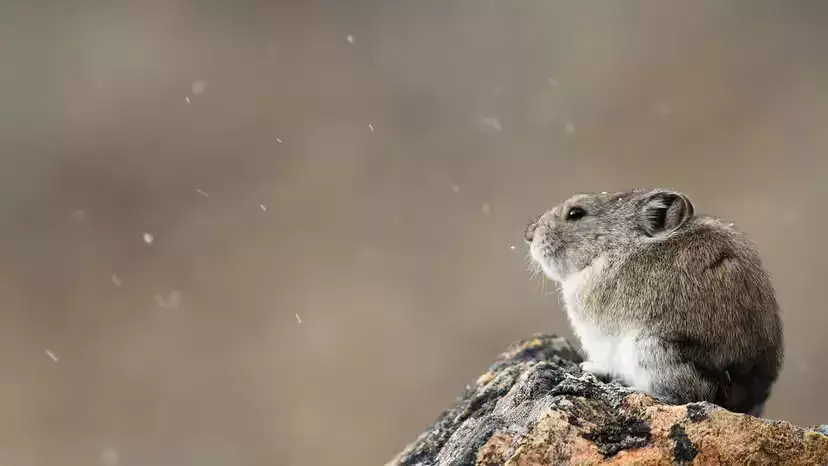Where it lives: High ridges and cliffy talus in China’s Tian Shan Mountains
Size: About 8 in (≈20 cm); round face, big ears, short gray-to-brown-spotted coat
Status: Critically endangered; likely fewer than 1,000 remain
Main pressures: Warming climate, shrinking alpine habitat, and grazing/human disturbance
Why so elusive: Rock-dwelling, quiet, small range; only a few dozen live individuals have ever been documented by researchers

The Ili pika—nicknamed the “magic rabbit” for its teddy-bear face and rabbit-like charm—is a rock-pika found only in the Tian Shan of northwestern China. First brought to science in 1983 by biologist Li Weidong, the species was later named for Li’s home region, Ili. Adults are palm-sized, with large rounded ears, a compact body, and short gray fur with brown mottling that blends into alpine scree.
1983: Li Weidong encounters an unfamiliar pika peering from talus and collects material for identification.
Mid-1980s: Additional encounters confirm a distinct species.
Since then, very few live sightings have been recorded—partly due to the species’ tiny range, cryptic behavior, and difficult terrain.
Length: ~20 cm (≈8 in)
Look: Rounded face, big ears, short tail (typical of pikas), dense gray coat with brown flecking
Behavioral tell: Quick dashes between rock crevices; often detected by a short, high call (when vocal) and by hay piles or clipped stems near den cracks
Endemic to the Tian Shan of Xinjiang, China
Elevation sweet spot: ~2,800–4,100 m (≈9,200–13,450 ft)
Micro-habitat: Talus and fractured cliffs adjacent to alpine meadows/shrubby turf—the pika nests in rock voids and feeds on nearby plants
This patchwork—rock for cover, alpine vegetation for forage—is critical. As warming pushes the snowline upslope, suitable cool, moist microclimates shrink and fragment.
Herbivore: alpine forbs, grasses, dwarf shrubs, and herbs near rock fields
Foraging style: quick sorties from crevices; clips vegetation and may cache it near den cracks
Activity: typically diurnal/crepuscular in cool conditions; heat and bright sun drive it under cover
Field teams have documented only a small number of live animals since discovery (reported in the tens, not hundreds).
Listed Endangered by IUCN in 2008 and widely regarded today as critically imperiled with a global total likely <1,000.
Climate Change
Rising temperatures reduce the cool talus microclimate the species needs.
Receding glaciers and altered snow/rain patterns compress suitable bands upslope; there’s literally nowhere higher to go.
Habitat Pressure
Grazing can simplify alpine plant communities, reducing food quality and cover.
Human presence (roads, tourism, extraction) disturbs fragile high-elevation sites.
Small, Patchy Populations
Tiny, isolated groups risk local extirpation from bad years, disease, or extreme weather—and may face inbreeding over time.
Since the 1980s, observers estimate steep declines (field estimates suggest on the order of ~70% in some areas). With climate warming accelerating in high mountains, the Ili pika is a canary of the cryosphere—a small alpine specialist squeezed by heat from below and rock and sky above.
Site-level protection: Buffer known talus patches; manage or reroute grazing and disturbance at sensitive elevations.
Micro-habitat stewardship: Maintain vegetation mosaics next to talus; protect snow-retaining aspects and moisture refuges.
Climate refugia mapping: Use topoclimate models to find and secure cool-air pooling sites and late-lying snowbeds.
Monitoring & research: Camera traps, acoustic surveys, non-invasive genetics from pellets/hair for population size and connectivity.
Community partnerships: Work with local herders and managers on seasonal grazing plans, signage, and low-impact access.
Awareness & funding: Channel ecotour interest (carefully) into on-the-ground protection and long-term research support.
There are 30+ pika species across Asia, North America, and Eastern Europe. Like the Ili pika, many depend on talus + meadow juxtapositions and haypiling (cutting and drying plants). Notable relatives include:
American pika (O. princeps) – Rocky talus of western North America
Collared pika (O. collaris) – Alaska/Yukon
Plateau pika (O. curzoniae) – Tibetan Plateau
Daurian & Northern pikas – Boreal/steppic Asia
The Ili pika stands out for its extreme rarity, very localized distribution, and tight association with high-elevation Tian Shan talus.
How does the Ili pika handle seasons?
It grows a thicker winter coat and relies on talus microclimates to buffer heat and cold; in summer it stays close to cool rock crevices and forages during cooler parts of the day.
What’s the single biggest current threat?
Warming alpine climates that erase cool, moist talus niches, compounded by grazing and disturbance that reduce cover and food.
Can captive breeding save it?
There’s no established captive program. For now, the most tractable, immediate gains come from protecting and managing wild habitat and pinpointing climate refuges the species can still use.
animal tags: ili pika
We created this article in conjunction with AI technology, then made sure it was fact-checked and edited by a Animals Top editor.